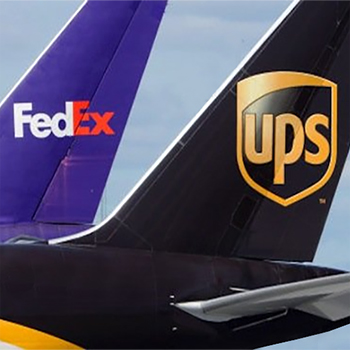For the first time in a long time the parcel duopoly of FedEx and UPS are both operating under very distinct pricing models that no longer match, including accessorial charges like fuel surcharges and list rates, which now makes it much more difficult for shippers to compare prices between the two.
The differences stem from rate announcements respectively by each company last fall.
UPS rolled out the following in September 2016:
The announced rate changes include;
- UPS U.S. Ground service will increase by an average net 4.9 percent, effective December 26, 2016;
- daily rates for UPS U.S. Air and International services will increase an average net 4.9 percent;
- UPS Air Freight rates within and between the U.S., Canada and Puerto Rico, will increase an average net 4.9 percent, also effective December 26, 2016;
- UPS Freight announced an average net 4.9 percent general rate increase effective September 19, 2016; and
- an additional handling surcharge will apply to any package with the longest side exceeding 48 inches, instead of 60 inches for all Air and International packages, with the additional handling charge increasing by $0.35. And it also said that effective January 8, 2017, the additional handling surcharge will also apply to UPS SurePost package
And not long after FedEx rolled out their own pricing changed, including:
- FedEx Express rates increasing by an average of 3.9% for U.S. domestic, U.S. export, and U.S. import services;
- FedEx Ground and FedEx Home Delivery rates increasing by an average of 4.9%, with FedEx SmartPost rates also changing;
- the FedEx Express and FedEx Ground U.S. domestic dimensional weight advisor will change from 166 to 139;
- FedEx Freight rates will increase by an average of 4.9%; and
- the FedEx Freight extreme length surcharge will change from $88 to $150 and be applied to shipments 12 feet or greater compared to the prior 15 feet
Perhaps the most significant change announced by FedEx was that fuel surcharges for FedEx Express and FedEx Ground will be adjusted on a weekly basis instead of the current process in which adjustments are made on a monthly basis with a two-month lag between U.S. government published fuel indexes and the fuel surcharges.
FedEx said that adjusting the weekly fuel surcharges will reduce lag time from two months to two weeks, providing a closer alignment between fuel costs and fuel surcharges at the time of shipment.
Rob Martinez, president & CEO, Shipware Systems Corp, a San Diego-based parcel consultancy, labeled said that the adjustment in the dimensional weight calculation is the most “striking” change rolled out by FedEx.
“Prior to 2011, the dimensional advisor was 194. Today, it is 166, and effective January 2, 2017, it will be reduced to 139, which is the current divisor for International Export and Import shipments,” he said.
“The shift for many shippers is cataclysmic. It is paralyzing to many shippers not under custom contract DIMs. ”
Martinez also noted that with this announcement FedEx did not match UPS’s rate increase, with FedEx taking a 3.9% increase on Express and International Export and Import products compared a 4.9% average for UPS, and the FedEx Ground minimum charge at $7.25 compared to UPS’s $7.32, along with the companies set to have totally different published rates for the first time in years.
Published rates no longer match, accessorials don’t precisely match, dimensional pricing rules don’t match, and fuel surcharges don’t match,” he said.
“With all these changes, it is harder than ever for shippers to easily compare services and pricing between FedEx and UPS. As all shipments will not be impacted in the same way, it’s important for shippers to understand to the differences between UPS and FedEx and thoroughly model the impact of all carrier pricing changes to their unique distribution.”
When asked about the pricing differences between UPS and FedEx, Jerry Hempstead, president of Hempstead Consulting, cited an old axiom bantered about in executive weeks along the lines of “in confusion, there is profit.”
And with these two companies seemingly setting new revenue and profit records each quarter, Hempstead said it speaks to how a shipper’s incumbent carrier has all the cards in a deal.
“They have the data on a customer’s book of business that delineates the usage by service type, by weight, by zone, with their profits coming out of the checking accounts of the customers of the carriers,” he said.
“They know the number of transactions that go to residential addresses, they know the dimensions of the packages, and they know the proportion that goes to extended and delivery area surcharge zip codes. The carrier also makes the rates and determines the pricing offer.”
As for the impact of the pricing changes between the duopoly, Hempstead said shippers can ask their representatives at UPS and FedEx for an impact study of the announced changes, with the carrier representative able to provide an analysis for a shipper to the penny, in a matter of minutes.
“The carrier can also show the detail of where the greatest impact will be,” he said. “So for example, if the big hit to a customer’s bill will be the change to the dim rule, this can help the shipper focus on packaging that will help reduce the pain.”
“Shippers need to know as much about their business as the carriers do, and this can be developed based on the carriers’ billing data. It’s become increasingly difficult for shippers though to take that model of their business and compare offers from the carriers because there are few easily available tools with the differing carrier base tariffs and fuel surcharges.”
“Many firms now see it in their interest to employ the services of a parcel professional who have dynamic pricing engines and can calculate the benefits of carrier offers.”
Related: Parcel Market Trends & Advice for Shippers
About the Author
Follow Robotics 24/7 on Linkedin
Article topics
Email Sign Up




















